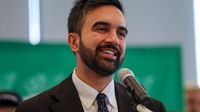In a political turn that has left pundits scrambling for historical analogies, Zohran Mamdani’s decisive victory in New York City’s Democratic mayoral primary on June 24, 2025, has sent shockwaves through the American political landscape. The 34-year-old state assemblyman, a member of the Democratic Socialists of America (DSA) and a practicing Muslim, not only defeated the heavily favored former governor Andrew Cuomo but did so by a margin few predicted. The scale and symbolism of Mamdani’s win have drawn comparisons to one of the most storied insurgent campaigns in U.S. history: Upton Sinclair’s 1934 bid for California governor. Yet, as history shows, the path from primary triumph to general election victory is anything but guaranteed.
According to The Conversation, Mamdani’s victory is reminiscent of Sinclair’s campaign nearly a century ago, when the famed author and longtime socialist stunned the nation by winning the Democratic primary with his radical “End Poverty in California” (EPIC) plan. Sinclair’s campaign, much like Mamdani’s, was propelled by a groundswell of grassroots activism—over 800 EPIC clubs sprang up across California, and volunteers sold the weekly EPIC News to fund the movement. Sinclair’s pamphlet, I, Governor of California and How I Ended Poverty, laid out his vision for state-run cooperatives to tackle unemployment, an idea that captured the imagination of a Depression-weary public.
But as the 1934 general election neared, business and media elites mounted a ferocious campaign to derail Sinclair, unleashing a barrage of attack ads, billboards, and relentless newspaper coverage painting him as a dangerous radical. The campaign even drew on religious anxieties, highlighting Sinclair’s atheism to stoke public fears. Ultimately, a split in the progressive vote and the full weight of establishment opposition handed victory to incumbent Governor Frank Merriam. As historian James N. Gregory, writing for The Conversation, notes, “Primaries are one thing. But in 1934, the November general election turned in a different direction.”
Mamdani’s supporters are keenly aware of these historical echoes. The forces arrayed against him are already formidable. The Guardian has reported that billionaire hedge funder Bill Ackman and other finance industry heavyweights have pledged “hundreds of millions of dollars” to oppose Mamdani’s campaign. This mirrors the 1934 warnings from Hollywood studios and major corporations threatening to leave California if Sinclair won. Media outlets like The Wall Street Journal and Fortune have amplified similar threats in 2025, warning of dire economic consequences should Mamdani take office.
Yet, the dynamics of the upcoming general election in New York differ in crucial ways from Sinclair’s ill-fated run. While Sinclair faced a three-way race that split the left, Mamdani’s opponents are more fractured. Former mayor Eric Adams, once a Democrat, is now running as an independent after being rescued from a corruption indictment by President Donald Trump. Cuomo, too, remains on the ballot as an independent, and Republican Curtis Sliwa is mounting his own campaign. As Gregory points out, “Whereas in 1934 two candidates divided progressive votes, in 2025 three candidates are going to divide the stop-Mamdani votes.”
Religion also looms large in the 2025 race. The New York City metro area is home to at least 600,000 Muslims and an estimated 1.6 million Jewish residents. Adams has stated that combating antisemitism will be a central theme of his campaign, echoing the way Sinclair’s opponents once weaponized religious identity. However, historical analysis suggests that such tactics may have limited impact on actual voting behavior. In Sinclair’s case, the emphasis on his atheism proved less important than economic and political factors.
Against this backdrop, the Democratic Socialists of America are riding a wave of newfound momentum. Over the weekend of August 9-10, 2025, 1,200 DSA members gathered in Chicago for the party’s convention, as reported by TNND and the Washington Free Beacon. The convention passed a resolution pledging “total solidarity with the Palestinian cause,” and much of the discussion centered on how Mamdani’s campaign could serve as a blueprint for a 2028 presidential run.
“We need to run campaigns that win,” declared Nate K, a delegate from Atlanta, during the convention. “Campaigns like Zohran Mamdani, which put forward a bold vision of a socialist society. Zohran shows that Palestine is a winning issue. That socialism is a winning issue.” Nate continued, “The time for protest campaigns and messaging is over. The time for winning is now. We can win the Democratic primary in 2028. There’s polls now that show that a majority of the Democratic primary electorate supports Palestine and would want a Democratic socialist to win the presidential primary in 2028.”
Indeed, a recent Wall Street Journal poll found that the Democratic Party’s approval rating has sunk to its lowest point in 35 years, a sign of widespread discontent and an opening for insurgent candidates. While Mamdani has yet to secure endorsements from top Democratic leaders like Senate Minority Leader Chuck Schumer and House Minority Leader Hakeem Jeffries, he has been backed by more than a dozen Democrats, including Rep. Jerry Nadler and New York Attorney General Letitia James. His proposal for government-run grocery stores—once dismissed as fringe—has become a rallying point for the party’s left flank.
The DSA’s growing influence is undeniable. There are now 250 Democratic socialists serving in public office across 40 states, with 90% elected in just the past six years. Rep. Alexandria Ocasio-Cortez and Sen. Bernie Sanders, both early champions of the movement, have been barnstorming the country on their “Fight the Oligarchy” tour, decrying corporate influence and calling for bold progressive reforms. Sanders, who ran for president in 2016 and 2020, has lent his considerable clout to the cause, helping to mainstream ideas once considered radical.
Still, the road ahead is fraught with challenges. The coalition that propelled Mamdani to victory in the primary will face an onslaught of negative advertising, big-money opposition, and a crowded general election field. The lessons of 1934 are not lost on today’s activists. As Gregory warns, “Business and media elites mounted a campaign of fear that put Sinclair on the defensive. Meanwhile, conservative Democrats defected, and a third candidate split progressive votes.” The question now is whether Mamdani and the DSA can avoid a similar fate—or if history is destined to repeat itself.
For now, the energy on the left is palpable. The DSA’s convention in Chicago was abuzz with talk of turning protest into power, of moving from the margins to the mainstream. Whether that momentum can survive the crucible of a general election—and translate into lasting change—remains to be seen. But one thing is clear: American politics is entering uncharted territory, with echoes of the past reverberating loudly in the present.
As the campaign unfolds, all eyes will be on New York, where the outcome could shape not only the city’s future but the direction of national politics for years to come.






